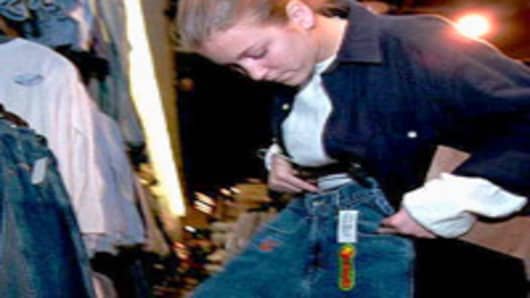"I think the month of April will be one of the stronger numbers you see, and I think it'll level out after that," said Dana Telsey, chief research officer at the Telsey Advisory Group, in an interview on CNBC.
"I think the consumers are strapped," she said. "I think that their wallets are definitely tighter this year than last year."
Consumers have been grappling with record high gasoline prices, rising costs for food, sagging home prices and worries about their jobs. Shopping patterns continued to suggest that consumers are hunting for bargains and postponing purchases of clothes and other non-necessities.
Telsey said she expects retailers will remain conservative with their sales and earnings forecasts in this environment.
"I think retailers are very nervous and cautious about the balance of 2008," Telsey said.
According to Thomson Financial, about 68 percent of the retailers that have reported their results so far have topped analysts' estimates, while 32 percent have fallen short.
Wal-Mart, the world's largest retailer, was among those retailers outpacing analysts' estimates. The retailer saw a stronger-than-expected 3.2 percent sales increase in stores open at least a year.
Analysts, on average, were expecting its same-store sales to rise 2.1 percent, according to Reuters Estimates, while Wal-Mart itself forecast a gain of 1 percent to 3 percent.
"The economy continues to get tougher and the 'paycheck cycle' is more pronounced for customers than in past months," said Eduardo Castro-Wright, head of Wal-Mart's U.S. store division. "As money gets tighter for them toward the end of the month, sales drop more than we have seen in the past."
Warehouse clubs Costco Wholesale and BJ's Warehouse also topped analyst estimates.
Costco said total sales rose 8 percent from a year ago, compared with an average analyst estimate of 6.1 percent.
"We are, of course, benefiting from some inflation on the food side as a result of the recent run up in the cost of commodities and the continued run up in the price of oil and gasoline," the company said.
Meanwhile, BJ's Wholesale said same-store sales rose 12.3 percent, excluding gasoline sales, and rose 17.8 percent including gasoline. Analysts were looking for an increase of 10.8 percent.
Other strong performances came from Family Dollar, which said same-store sales rose 4.3 percent, and discounter TJX , which said same-store sales rose 8 percent.
Meanwhile several children's apparel retailers also performed well.
Children's Place reported a 15 percent gain in April same-store sales, far outstripping the 5.5 percent gain estimated by reported by Thomson.
Gymboree, another children's apparel retailer, boosted its first quarter and fiscal year profit guidance due to higher-than-expected quarterly sales. Same-store sales rose 4 percent.
J.C. Penney benefited from its consumer promotions. The retailer said its same-store sales fell 1.7 percent, which was far less than expected, as warm weather in parts of the country boosted seasonal clothing sales.
But perhaps the biggest surprise came from high-end retailer Saks , which said same-store sales rose 23.9 percent in April. Analysts were looking for a gain of 1.1 percent.
However, rival JW Nordstrom posted a sales decline of 3.8 percent, which was much deeper than 1.8 percent decline expected by analysts. Nordstrom was not alone in it reporting a sales shortfall.
Target also missed analysts estimates as consumers stuck to the basics and avoided higher margin items such as jewelry.
The Minneapolis-based discount retailer says same-store sales for the four-week period ended May 3 rose 3.1 percent, missing the 3.1 percent growth expected by analysts polled by Thomson Financial.
Other notable misses came from Gap and Limited Brands.
Gap said it continues to be challenged by slow store traffic, but it was able to reaffirm its forecast for the year. Gap expects to earn between $1.20 and $1.27 a share, while analysts polled by Thomson Financial, on average, expect a profit of $1.23 per share.
Limited Brands reported a 5 percent drop in same-store sales, worse than the 2.3 percent analysts forecast.
Pacific Sunwear of California posted a 4 percent increase in same-store sales, below the 5.6 percent estimate.



